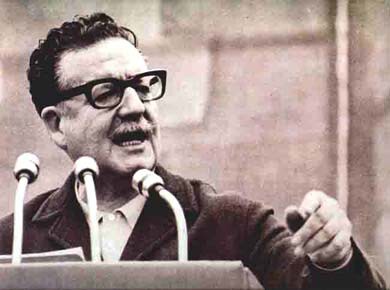To those who at the beginning of the 70s set foot in the Operations room of the national telecommunications company of Chile, in the center of the capital of Santiago, one of the first ideas that must have crossed their minds was to turn around in search of Spock or Captain James T. Kirk. If there has ever been an office that resembled the emblematic ship Enterprise from the Star Trek series, it was that of that revolutionary administration of the times of Salvador Allende.
Fiberglass swivel chairs, orange cushions, screens with futuristic designs. 70s pop aesthetics in its purest form. An office without tables or paper from which the future was to be laid and, precisely for that reason —Explain The New Yorker—, it must have “resembled” the future.
It was not be for lowerly.
What housed that prototype room in the Chilean capital was the heart of the Cybersyn Project —a word taken from “cybernetic synergy”—, the most ambitious attempt of the Allende administration to implement a communication system capable of connecting the government, companies and voters, a nationwide, interactive network that would facilitate the planning and control of the economy.
the seed of a “socialist internet” planted shortly after the Department of Defense in the US did the same with ARPANET, today considered the origin of the current Internet.
The company was revolutionary and even came to be led by one of the great cybernetics theorists of the 20th century, Stafford Beer; but he ended up severed by the coup of 1973.
An “electronic nervous system”
Towards 1971once the optimism that followed the democratic rise of Allendehis government found itself with the delicate task of organizing state enterprises and the activity recently nationalized. The challenge was to impart some logic to this chaotic and often inefficient collection of factories and mines. And to do it, moreover, fleeing from the Soviet centralized model.
The million dollar question was: How?
Among the technocrats who were to take on the task was a 28-year-old engineer, Ferdinand FlowersAllende’s confidant. In the 1960s, Flores had soaked up the revolutionary ideas of Stafford Lee on cybernetic administration and thought that Chile could be an ideal terrain to put some of them into practice. Beer’s luxurious lifestyle in the United Kingdom and, above all, his busy schedule suggested that the British intellectual probably did not want to embark on Chile’s socialist adventure; but still Flores and his team decided to try their luck.

They wrote him a letter inviting him to the Andean country and they crossed their fingers.
It worked. Of course. Instead of sending one of his collaborators, Beer collected his gear, packed his bags, and sailed to Chile instead —precise Guardian—of a payment of 500 dollars a day, an amount slightly less than his usual minute but which he compensated by demanding a good supply of chocolate, wine and cigarettes. Genius stuff, you know.
Over the next two years, Beer and his collaborators would shape the Cybersyn Projectan attempt to provide Chile with an authentic “electronic nervous system”. The idea was to establish an ambitious communication model capable of covering the entire country and speeding up the sending of economic data, a network that would allow monitor resourcesneeds and results.
A photograph of the Operations Room, Project Cybersyn, in Chile, 1971-3 from the Stafford Beer Archive #InternationalArchives #ExploreArchives pic.twitter.com/vfJxx1S6s5
— LJMU SCA (@LJMU_SCA) November 25, 2018
For such a challenge, however, its promoters had more vocation than real means.
The technology it was archaic and the team even reached for 500 telex machines bought back in the day by the previous government and gathering dust in a warehouse. The devices were distributed and ended up connected to two control rooms in Santiago, where a team of technicians was in charge of collecting statistics and analyzing them. The prototype operating room —precise The New Yorker— was that peculiar imitation of Interprise located in the heart of Santiago de Chile.
As part of the process, a hundred companies and their managers were connected developed the Chilean Economic Simulator (CZECH) and the prototype of a statistical software, Cybestryde. To get their work they used the Burroughs 3500 computer.
“It was an impressive machine for what was then fashionable […]. There were mainframes the size of washing machines, with eight aligned disks of a few megabytes in total, less than a simple mobile phone has today.” explains Tim Harford in his book adapt.
The objective was not to monitor the population, but rather that it could have more weight in the administration of the places where it worked. The level of participation, however, was not always what was expected.
That does not mean that Cybersyn had some small victory. When in October 72 a strike backed by the CIA attempted to put the nation’s economy on the ropes, Beer’s system helped the government coordinate its response and avoid shortage. Thanks to the telex network, the flow of requests and complaints between work centers and the government was also facilitated.
That ambitious seed of the socialist Internet would not go much further. As it progressed, the project began to encounter problems and the winds of politics were not in its favour.
September 11, just a day later that the workers had taken measures in La Moneda to install there a modern Cybersyn control room full of panels and screens, coup was declared that would end up leading to the death of Allende and the beginning of the Pinochet dictatorship. When the military rebels came across that display of modernity so little in keeping with the 70s, they decided to smash it to pieces. Beer had to follow him from England.
Today it remains as one of the most fascinating chapters of the technological history of the 20th century.
Pictures | Wikipedia















![[Img #74662]](https://thelatestnews.world/wp-content/uploads/2024/12/Organisms-with-the-shortest-life-300x200.jpg)
Add Comment